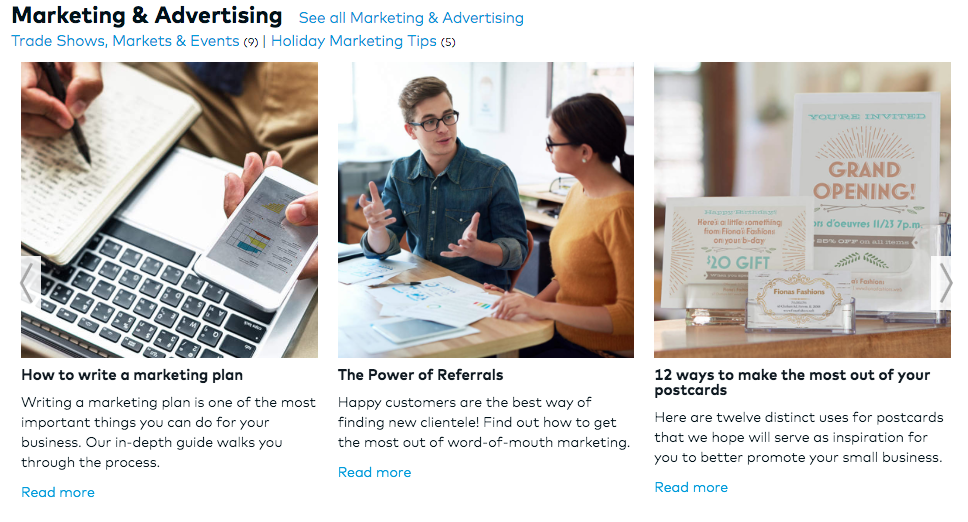Creative Thinking
For Vistaprint, Content Marketing Is All About Customer Centricity
By Rachel Haberman on May 29, 2018
Business printing is not, on its face, the sort of industry that usually inspires an emotional response-but Vistaprint's content marketing team will happily prove you wrong on that account.
For Sarah Nunes, director of brand communications, and Leona Frank, senior manager of brand, content, and social, their challenge has been to advocate for brand storytelling in a company that has long focused on direct response marketing. They've answered that challenge by tying their content strategy into the company-wide focus on customer centricity, providing their audience of small business owners with not only resources to support their businesses but also an emotional connection with others small business owners who are addressing the same challenges.
I spoke to Sarah and Leona ahead of their session at Forward 2018, where they will share Vistaprint's story of adopting story-centric marketing.
Don't Just Know Your Audience-Love Your Audience
Vistaprint uses the term "small business" to describe their target customer, but as Sarah explains, "It's not small business as traditionally defined. It is zero to ten employees, mostly sole proprietors, one or two employees. It's a very specific niche within small business."
As the Vistaprint team realized, while there might be a lot of information available for small businesses, there was no one speaking to their specific niche about the challenges their customers faced every day. "We felt like that was a hole that we could and should fill as a responsibility that we had to these few people who are our customers," says Sarah.
Their response to that hole is Vistaprint's "Ideas and Advice" blog, a resource that goes beyond the basic design advice you'd expect from a printing services company to address questions about marketing, branding, and advertising, all through the lens of a micro-business.
Creating content for an under-served niche is an obvious win in terms of organic search, but it's clear that the opportunity is larger than that. The empathy that Sarah and Leona-and no doubt the rest of the Vistaprint team-feel toward this audience is apparent throughout our conversation, and it deeply influences their approach to content marketing.
"Our mission with the blog was really to help customers be successful in running their small business-and that goes beyond just printing. So we need to give them a resource from a brand they trust that allows them to live their dream," says Leona. "For the small business owner we target, usually their small business is like their baby. That's really what they want to do."
"It's a group that doesn't get a lot of focus, that feels very isolated, that a lot of times may think they don't know what they're doing and don't know who to go to for help," Sarah adds. "We are trying to think about how we digitally create some of that connection, not only with how Vistaprint supports and elevates these small business owners but also how they can support and elevate each other, how they can learn from each other, how they can relate to each other, how they can understand that they're not alone, that everyone's gone through similar things."
Content Marketing as Customer Centricity
The road to a well-resourced content marketing operation was a long one, but one particular opportunity that they've smartly turned to their advantage was a brand strategy that focused on customer centricity across the organization.
"We are very fortunate in the sense that we have made the shift of being entirely customer-driven. And so, if we can do something that helps our customers be successful, that is a very, very strong business case," says Leona. "We've done market research where we realized that, in some cases, people were unhappy with our products, not because the products themselves were faulty, but because they used them for the wrong use case. So there was a very strong business case that helping customers understand marketing better-that's where we started out originally-would ultimately help the bottom line."
Framing content marketing through the lens of customer centricity gave the team the perfect opening to sell content to the larger marketing team. "We looked at the marketing calendar, and we looked at what was going to be talked about from a product perspective. Then we looked for the insights behind the use of those products or the needs someone might have, and we leveraged those insights to develop the more educational, broader content and then sold that into the marketing teams to help further their cause," says Sarah.
From that initial foothold, they built support for a broader content mission. Sarah continues, "We were able to build up that internal credibility because we were able to come to these teams that didn't have as much customer data and say, 'Hey you guys, we really are getting customers. We've done the research. Here's what they need.' And the more that we were able to do that, the more we were given license to take that even further."
In doing so, they've struck a balance that eludes many content marketers: addressing their product marketing needs without creating solely product-driven content.
Image attribution: Ellyot
Making Content Marketing Stick
Building that internal credibility was crucial, but it wasn't enough. To really make content marketing an indispensable resource, they had to push their way into other distribution channels.
"This is definitely something that we had to fight for every little bit," Leona laughs, "but now we're in a good place. We have a massive email database-we served 60 million customers last year. The email channel was the first channel that we contacted and tried to support, which is not easy because, of course, any real estate given up is real estate where you may not be able to put an offer and drive more sales."
The key to winning them over was showing that content wasn't competing for space for promotional offers but actually making those offers more effective. "You can offer 100 postcards for $10," says Leona, "but if somebody doesn't even know how to use this postcard or how that helps their business, then they won't click the offer either."
From email, they moved on to social, and then other channels followed suit, including retargeting and paid search. They even partnered with direct mail to put more use cases in their catalogs, showcasing customer stories and advice for making the most of their marketing solutions alongside the products themselves.
Image attribution: Ben White
Brand Storytelling in a Direct Response World
On the topic of storytelling, Sarah paraphrases Maya Angelou: "People won't remember what you say, but they'll remember how you made them feel-and in a direct-response-oriented company, there's not a lot of space to make someone feel something."
Having established their credentials as a source of advice, the Vistaprint team is setting their sights on building their brand through emotional connection. "More and more we're realizing that we've been neglecting our brand, and we've been neglecting it for a long time," Sarah says. "I think part of us all coming together is realizing there's a lot more that we can do here, and it matters, and we need to be more thoughtful about how we do that work."
Leona returns to customer centricity as the driver of content marketing, this time referring not just to the informational needs of the customer but to their emotional needs: "We've done extensive customer research, and we kept on hearing that they need to feel, they want to hear stories of people they can relate to. So there was little point for us to go to, I don't know, Shark Tank, and tell that story or talk about those people. They really wanted to hear from other small business owners who went through what they went through, who started out small or who started out with a passion. And so that allowed us to really go down the storytelling angle to find people and tell them, 'Just tell us how you started your business. Tell us what it was like to hire your first employee.' Because we realized that our customers can really identify with those moments when they come from a peer."
Sarah and Leona both readily admit that they are still experimenting, figuring out what storytelling can look like for Vistaprint, how it will create connections with their customers, and what it will mean for attribution models and measurement-but they share an ambitious vision.
Says Sarah, "My vision is that content marketing will be just marketing. It will be the center of marketing, and all of these other channels will be supporting channels versus a little bit of the vice versa, where we are now. I think that the landscape is shifting, and the way that people want to interact with brands is changing, and the reputation of brands is changing.
"And I think that the way to live up to these expectations is through authentic, relevant, interesting, engaging content across multiple platforms. That is what marketing is going to look like not that long from now, when no one's watching us on TV anymore and no one sees display. When all of that is just background noise, it's going to be about those relationships that we were able to build."
Sarah Nunes and Leona Frank of Vistaprint will speak at Forward, Skyword's annual brand storytelling conference, on June 14, 2018. Learn more at skyword.com/forward.
Featured image attribution: Helena Lopes




